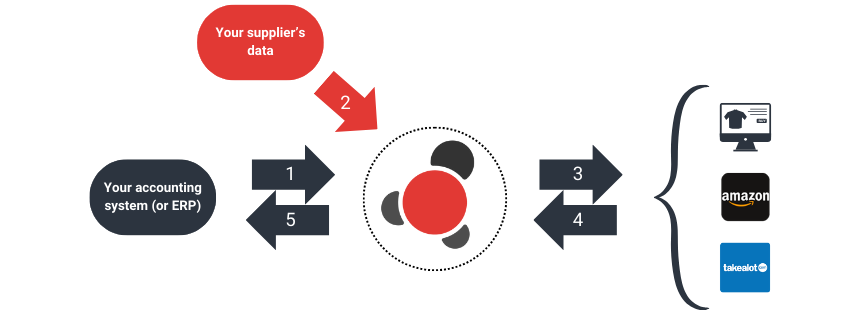Be first to know
Keep up to date with ecommerce news, trends and articles. Brought to you by Stock2Shop.
Sign up todayMany people new to ecommerce view dropshipping as a risk-free way to make easy money online. While it’s true that the financial barrier to entry is significantly lower than traditional retail models, the pitfalls of dropshipping (especially in South Africa) are well documented. These include:
With Stock2Shop, you can add an element of automation that reduces the risk of stockouts. If your supplier is prepared to grant access to their inventory database, you can sync live stock (and other relevant data) updates to your website, Amazon, Takealot and other online sales channels. Below is an overview of how it works.

Your ERP (or accounting system) should typically be your primary data source. Product information is synced to Stock2Shop where you can add marketing material such as images, descriptions and cateogrisation.
Your supplier’s database can be added to your Stock2Shop console as a linked source. This means that inventory and other relevant data can be automatically updated to reflect near-live stock availability. NB: It is important that the item codes on your supplier’s database correlate with the codes on your accounting system.
Now that your items have synced from your accounting system to Stock2Shop where they have been updated with accurate stock levels from your supplier’s data, you can send them to your ecommerce sales channels. Note: Some platforms limit which data they accept via a product feed. Please check the details with your Stock2Shop sales agent.
When a customer buys one of your products online, the order will be sent back to Stock2Shop.
Online orders can be synced into your accounting system (or ERP) as an invoice or sales order. If you sell on multiple ecommerce platforms, each channel can sync orders into its own default debtors account, making reconciliations easier.
With Stock2Shop, you can accept online sales with confidence while knowing that your online sales channels reflect stock levels as per your supplier’s inventory database. Call us now to find out how we can help you reduce the risk of stockouts.

Keep up to date with ecommerce news, trends and articles. Brought to you by Stock2Shop.
Sign up todayUnderstanding product data is essential for a successful ecommerce business. Here’s an overview of the most important elements of product data you need to understand.
Read MoreCategorising products correctly is a major pain point for many ecommerce websites. Layered navigation is the solution: find out how – and why – to implement it
Read MoreWant to find out exactly how Stock2Shop can make your business more efficient and streamlined?
Contact Us